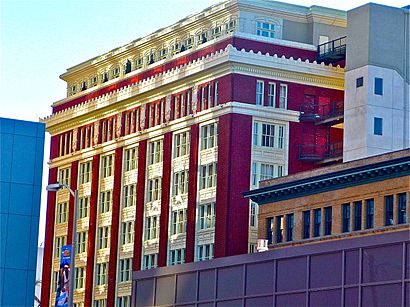Denver streetcar strike of 1920 facts for kids
Quick facts for kids Denver streetcar strike |
|||
|---|---|---|---|

Denver Tramway Company building, newly built as its headquarters in 1912
|
|||
| Date | August 1–6, 1920 | ||
| Location | |||
| Caused by | Lower wages for streetcar workers | ||
| Methods | Striking, rioting, street fighting | ||
| Parties to the civil conflict | |||
|
|||
| Casualties | |||
| Death(s) | 7 | ||
| Injuries | 50 | ||
The Denver streetcar strike of 1920 was a major event in Denver, Colorado. It was a big fight between streetcar workers and the company. It also involved the police, soldiers, and the public. The strike started on August 1, 1920, and lasted for six days. Sadly, seven people died, and 50 were seriously hurt. This event was one of the biggest and most violent worker disputes in transportation history. It even involved federal troops.
Contents
Why the Strike Happened
Denver's Public Transport
The Denver Tramway company provided public transportation for Denver. They ran streetcars, which were like electric buses on tracks. The company started in 1886. At first, they had rivals, but by 1895, Denver Tramway was the only streetcar company left.
Public Opinion and Fares
Over time, people in Denver started to dislike the company. This was because of how it did business. In 1906, the company got a special agreement called a "franchise." This agreement let them operate streetcars. It set the fare at 5 cents for each ride. The company also had to pay for half of the road repairs where their tracks were.
As more cars appeared, road repairs became very expensive. Even though many people rode the streetcars (62 million trips in 1917!), the company could not raise its fares. They asked for a 2-cent fare increase. But the city of Denver said no. In 1919, Dewey C. Bailey became mayor. He promised to keep the fare at 5 cents. Because of this, the Denver Tramway company cut jobs and lowered workers' pay.
Workers Form a Union
Streetcar workers had formed a union in 1918. It was called Local 746. The union helped workers get better conditions. They won an eight-hour workday and a pay raise. But the Denver Tramway company did not follow these rules. They cut workers' pay again. This led to a four-day strike in July 1919.
Tensions grew worse in 1920. In July, the company threatened to cut wages again. They said they would do this unless the city allowed higher fares. The public did not want higher fares, and the city refused. So, the workers voted to strike. They gave the company a deadline of August 1. The company then hired a man named John "Black Jack" Jerome. He was known for breaking strikes.
The Strike Begins
City Comes to a Halt
The strike stopped the city's streetcars. On August 3, John Jerome arrived by train. He brought 37 men with him. These men were a mix of college students, guards, and detectives. They were also armed by the city as special officers.
On August 4, Jerome himself drove the first streetcar to challenge the strikers. A crowd of people quickly overturned the car. This started a big fight between Jerome's men and the union supporters. Three streetcars managed to go around the city.
Violence Erupts
The first serious violence happened on Thursday, August 5. Union supporters were marching. They met two streetcars heading back to the barn. That evening, several angry crowds formed in the city. One crowd of 2,000 people attacked the Denver Post building and the Tramway Building. The Denver Post was a newspaper that was against the union. Another crowd went to Union Station looking for Jerome. Other groups fought with police in downtown Denver. That night, two people were killed, and 33 were wounded. This included the chief of police.
Early on Friday, August 6, Mayor Dewey C. Bailey announced that the police could not handle the violence. Almost one-third of the police force was hurt. Mayor Bailey asked for 2,000 citizen volunteers to help as a militia. The violence continued. That evening, five more people were shot and killed. Twenty-five were wounded. This happened at the East Division car barns. Strikebreakers fired into a crowd of people there.
How the Strike Ended
Later on Friday, Mayor Bailey and Governor Oliver Shoup asked for help from the federal government. Colonel C.C. Ballou arrived early on Saturday, August 7. He brought 250 soldiers from Fort Logan. He put Denver under martial law. This meant the military took control of the city. The violence stopped almost right away.
Ballou's commander, Major General Leonard Wood, came to see the situation on August 9. He later said that giving weapons to the strikebreakers was a "huge mistake." After the strike, the Denver Tramway Company went out of business. The strike also destroyed the workers' union in Denver. It did not form again until 1933. All seven people who died during the strike were bystanders, meaning they were not directly involved in the fighting.

